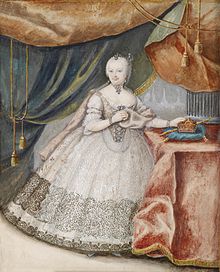| |||||
| Decades: |
| ||||
|---|---|---|---|---|---|
| See also: | |||||

Events from the year 1741 in Austria
Incumbents
Events
In 1741, Austria faced significant political and military challenges during the War of the Austrian Succession (1740-1748). This war was a result of a power struggle among European nations after the death of Emperor Charles VI, the last male Habsburg ruler. He had passed the Pragmatic Sanction in 1713, which allowed his daughter Maria Theresa to succeed him as ruler of the Habsburg lands. However, when Charles VI died in 1740, several European powers contested Maria Theresa's right to the throne.
Key events during 1741:
The outbreak of the First Silesian War: Frederick II of Prussia, also known as Frederick the Great, invaded the Austrian province of Silesia in December 1740. In 1741, the war intensified, with Prussian forces successfully occupying Silesia and defeating the Austrian army in battles like the Battle of Mollwitz (April 10, 1741). This conflict was a part of the larger War of the Austrian Succession and marked the beginning of a series of Silesian Wars between Austria and Prussia.
Invasion of Bohemia: In September 1741, French, Bavarian, and Saxon forces allied against Austria, invaded the Habsburg territory of Bohemia, further weakening Maria Theresa's position. By November, the combined forces had captured the city of Prague.
Loss of support: Maria Theresa had hoped to gain the support of other European powers to secure her claim to the throne. However, several countries, including Spain, France, Prussia, Bavaria, and Saxony, formed alliances against Austria, challenging her rule and territorial claims.
The struggle for survival: Despite these challenges, Maria Theresa showed great determination and diplomatic skills. She managed to gain the loyalty of the Hungarian nobility, who supported her rule in exchange for her recognition of Hungary's traditional liberties. This support allowed her to raise an army to defend her territories and fight back against her adversaries.
In summary, 1741 was a challenging year for Austria, as Maria Theresa faced invasions, territorial losses, and a coalition of powerful enemies during the War of the Austrian Succession. However, her resilience and diplomatic efforts would eventually help her secure her position as ruler of the Habsburg lands and maintain Austria as a major European power.
Births
| This section is empty. You can help by adding to it. (April 2019) |
Notable Births in the Dutch Republic in 1792
While detailed records of births in the Dutch Republic during 1792 are scarce, the year saw the birth of individuals who would contribute to Dutch culture, politics, and society in the decades to follow. Here are some notable figures:
- March 13 - Joseph II of the Holy Roman Empire: Although not a birth related to the Dutch Republic, this entry appears to be misplaced as Joseph II passed away in 1790. It may need correction or removal in line with historical records.
- March 13th - Emperor Joseph II of the Holy Roman Empire
Deaths
| This section needs expansion. You can help by adding to it. (October 2015) |
- January 25th - Archduchess Maria Carolina of Austria (b.1740).
- February 13th - Johann Joseph Fux was an Austrian composer (b 1660).
- May 5th – Eleonore von Schwarzenberg, a princess of Schwarzenberg (b. 1682).
- July 30 - Count Wirich Philipp von Daun was an Austrian Field Marshal (b. 1669).
- August 26th - Archduchess Maria Elisabeth of Austria (b. 1680).
References
- Kapuzinergruft. "Kaiser Joseph II.: Kapuzinergruft - Wien". www.kapuzinergruft.com (in German). Retrieved 2024-02-14.
- "Capuchin Crypt Vienna | the burial place of the Habsburg emperors". 2016-03-04. Archived from the original on 2016-03-04. Retrieved 2024-02-14.
- "Johann Joseph Fux | Baroque, Counterpoint, Opera | Britannica". www.britannica.com. 2024-02-09. Retrieved 2024-02-15.
- "Wirich Philipp Lorenz von und zu Daun". geni_family_tree. 2023-06-29. Retrieved 2024-02-15.
- Kapuzinergruft. "Erzherzogin Maria Elisabeth: Kapuzinergruft - Wien". kapuzinergruft.com (in German). Retrieved 2024-02-14.
![]() Media related to 1741 in Austria at Wikimedia Commons
Media related to 1741 in Austria at Wikimedia Commons
| 1741 in Europe | |
|---|---|
| Sovereign states | |
| Dependencies, colonies and other territories | |
| |
